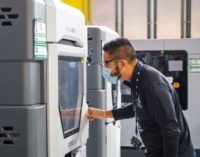In the future, the “smartest" form of assembly may be no assembly at all. That’s the goal of additive layer manufacturing.
In the future, the “smartest” form of assembly may be no assembly at all. That’s the goal of additive manufacturing, the process of joining materials to make objects from 3D model data, usually layer upon layer, as opposed to traditional “subtractive” manufacturing methodologies.
Additive manufacturing (AM) can be used to build physical models, prototypes, patterns, tooling components and production parts in plastic, metal, ceramic or composite materials. Engineers use thin, horizontal cross sections from computer-aided design models, 3D-scanning systems, medical scanners and video games to produce parts that may be difficult or impossible to produce any other way.
“Using AM for part production is considered the next frontier, with opportunities beyond measure,” says Terry Wohlers, president of Wohlers Associates, a consulting firm that specializes in rapid product development and additive manufacturing. “Corporations, entrepreneurs, investors and researchers are considering ways in which AM can be used to manufacture an exciting array of products in quantities of one to several thousands.”
Engineers at EADS, the European aerospace and defense group that is the parent of Airbus and Eurocopter, recently “assembled” a bicycle using the technology, which they call additive layer manufacturing (ALM). They claim it “has the potential to transform manufacturing around the globe.”
The Airbike is made of nylon and requires no conventional assembly. It is grown from powder, allowing complete sections to be built as one piece. Wheels, bearings and axles are incorporated within the growing process and built at the same time.
The Airbike can be built to rider specification, so it requires no adjustment. Unique design features include an integrated truss structure in the frame to reduce weight but maintain stiffness, and a Kevlar belt that creates a clean drive system.
Additive layer manufacturing allows single products to be grown from a fine powder of metal, such as aluminum, stainless steel or titanium. The bike design was perfected using computer-aided design and then constructed by using a laser-sintering process that adds successive, thin layers of the chosen structural material until a solid, fully-formed bike emerges.
While the Airbike is only a technology demonstrator at this stage, EADS has developed the technology to the extent that it can manipulate metals, nylon and carbon-reinforced plastics at a molecular level, which allows it to be applied to high-stress, safety-critical aviation uses. Compared to a traditional, machined part, those produced by ALM are up to 65 percent lighter, but still as strong.
According to the EADS engineers, the ALM process uses about one-tenth of the material required in traditional manufacturing and reduces waste. They believe that ALM offers potential for products to be produced quickly and cheaply on printers located in offices, shops and houses. For instance, it would allow replacement components to be produced in remote regions, improving logistics on humanitarian relief and military operations.
“The possibilities with ALM are huge-it’s a game-changing technology,” claims Andy Hawkins, lead engineer for ALM at EADS. “The beauty is that complex designs do not cost any extra to produce. The laser can draw any shape you like. [For instance], many unique design features have been incorporated into the Airbike, such as the auxetic structure to provide saddle cushioning or the integrated bearings encased within the hubs.
“Further ahead, by removing production lines and the need for factories, the costs of manufacturing will be significantly reduced,” adds Hawkins. “Through this, ALM has the potential to reverse trends of urbanization that have historically accompanied industrialization.
“Whilst there are currently limitations in terms of the maximum component size achievable and the costs involved, the technology is developing fast,” Hawkins points out. “There is growing recognition of the potential ramifications of ALM and the barriers to delivering this technology on a global scale are falling rapidly.”
Get our new eMagazine delivered to your inbox every month.
Stay in the know on the latest assembly trends.
SUBSCRIBE TODAY!Copyright ©2024. All Rights Reserved BNP Media.
Design, CMS, Hosting & Web Development :: ePublishing

